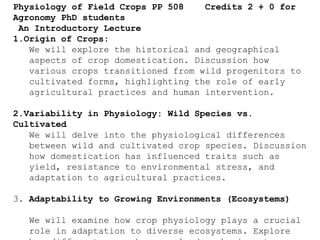
Physiology of Field Crops - Cereals and food grains
- 1. Physiology of Field Crops PP 508 Credits 2 + 0 for Agronomy PhD students An Introductory Lecture 1.Origin of Crops: We will explore the historical and geographical aspects of crop domestication. Discussion how various crops transitioned from wild progenitors to cultivated forms, highlighting the role of early agricultural practices and human intervention. 2.Variability in Physiology: Wild Species vs. Cultivated We will delve into the physiological differences between wild and cultivated crop species. Discussion how domestication has influenced traits such as yield, resistance to environmental stress, and adaptation to agricultural practices. 3. Adaptability to Growing Environments (Ecosystems) We will examine how crop physiology plays a crucial role in adaptation to diverse ecosystems. Explore
- 2. •Importance in Food Grain Contribution: Highlight the pivotal role of field crops in global food production. Discussion major crops contributing to food security, emphasizing their nutritiona value and economic significance. Explore how advancements in crop physiology contribute to enhancing yield and nutritional content. •Environmental Stress Responses: Discussion how field crops respond to abiotic stresses (e.g., drought, salinity, temperature extremes) and biotic stresses (e.g., pests, diseases). Explore physiological mechanisms and adaptations that allow crops
- 3. •Origins of Agriculture Agriculture emerged independently in various regions around the world. Discuss the importance of the Fertile Crescent, Mesoamerica, China, and other cradles of agriculture where early human societies transitioned from hunter-gatherer lifestyles to settled farming communities.
- 4. Variability in Physiology of Crop Plants: Wild Species vs. Cultivated 1. Introduction to Variability: Crop plants exhibit substantial physiological differences between their wild progenitors and cultivated forms. This variability arises from selective pressures imposed by human cultivation practices over millennia. 2. Timeline of Crop Evolution: Explanation: The process of crop evolution involves several stages: Wild Progenitors (Pre-domestication): Wild plants adapted to diverse ecosystems. Domestication (10,000 - 2,000 BCE): Initial cultivation and selective breeding by early agricultural communities. Modern Cultivars (Post-2,000 BCE): Continuous refinement and breeding for specific traits.
- 5. 3. Examples of Physiological Variability: a. Seed Characteristics: Explanation: Wild progenitors often have smaller seeds with natural mechanisms for seed dispersal. Example: Teosinte (wild maize) had small, hard seeds compared to the larger, non-shattering seeds of cultivated maize. b. Plant Architecture: Explanation: Changes in plant structure and growth habits due to human selection. Example: Domesticated wheat has a compact growth habit compared to the tall, brittle stalks of its wild ancestor, einkorn wheat.
- 6. Reproductive Strategies: Explanation: Adaptations in flowering and reproductive strategies influenced by human cultivation. Example: Wild relatives of tomatoes have small, inconspicuous flowers, while cultivated tomatoes have larger, showy flowers with increased yields. d. Stress Responses: Explanation: Altered responses to environmental stress, reflecting adaptability to cultivation. Example: Domesticated rice varieties often exhibit increased tolerance to waterlogged conditions compared to their wild ancestors.
- 7. • Nutrient Uptake and Utilization: Explanation: Changes in nutrient acquisition and utilization for optimized crop yields. Example: Cultivated maize varieties often have improved nitrogen uptake compared to wild varieties. • 4. Adaptability to Growing Environments: • a. Climate Adaptations: Explanation: Crops evolved to thrive in specific climates, impacting factors like temperature tolerance and photoperiod sensitivity. Example: Wheat varieties adapted to different climates – durum wheat for hot and dry regions, and bread wheat for cooler climates.
- 8. b. Soil Preferences: Explanation: Variability in soil adaptability, affecting nutrient uptake and water retention. Example: Different rice varieties are adapted to flooded (paddy) or well-drained soils. c. Biotic Stress Resistance: Explanation: Developments in pest and disease resistance. Example: Modern varieties of potatoes are bred for resistance to late blight, a devastating disease.
- 9. Water Management: Explanation: Adaptations for water use efficiency and drought tolerance. Example: The evolution of drought-resistant varieties of crops like millets and sorghum. 5. Conclusion: The variability in crop physiology between wild and cultivated species is a testament to the transformative impact of human intervention. Understanding this evolution aids in the development of crops with improved yields, resilience, and adaptability to a changing agricultural landscape.
- 10. 1.Wheat: Ancient varieties of wheat, like einkorn and emmer, had much smaller seeds compared to modern wheat. These ancient grains were also more difficult to thresh, as the seeds were tightly enclosed in a husk. 2.Maize: Perhaps one of the most dramatic transformations through domestication is seen in maize. The wild ancestor of maize, teosinte, has small, hard kernels that are vastly different from the large, soft kernels of modern corn. 3.Tomatoes: Wild tomatoes were originally small, similar in size to berries. Through domestication, they have been bred into the larger, juicier fruits we are familiar with today. 4.Bananas: Wild bananas are small and have large, hard seeds. The bananas we consume today are seedless and much larger, a result of selective breeding for these traits. 5.Watermelons: Ancient watermelons had a harder, bitter flesh and were much smaller. They have been bred to be larger, sweeter, and juicier. 6.Apples: Wild apples are typically small and tart. Domesticated apples are much larger, sweeter, and have a variety of textures and flavors. 7.Carrots: Wild carrots are thin, woody, and have a strong, sometimes unpleasant flavor. Domesticated carrots are larger, sweeter, and have a more palatable texture. 8.Peaches: Wild peaches were small, cherry-like fruits with large pits. Modern peaches are much larger, with smaller pits and sweeter flesh. 9.Squash and Pumpkins: The wild ancestors of squash and pumpkins had much smaller fruits and were not as fleshy or flavorful as the varieties we grow today.